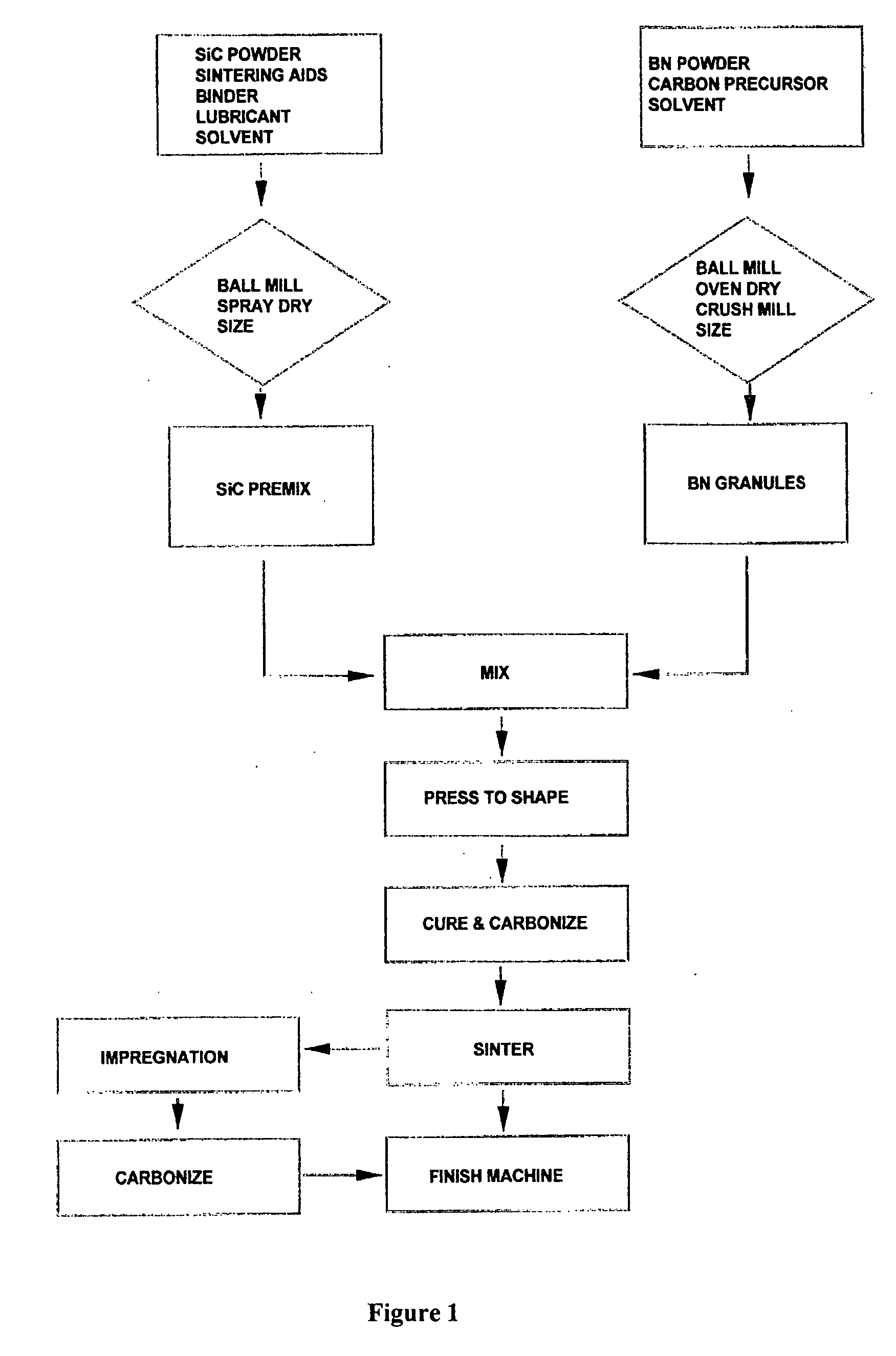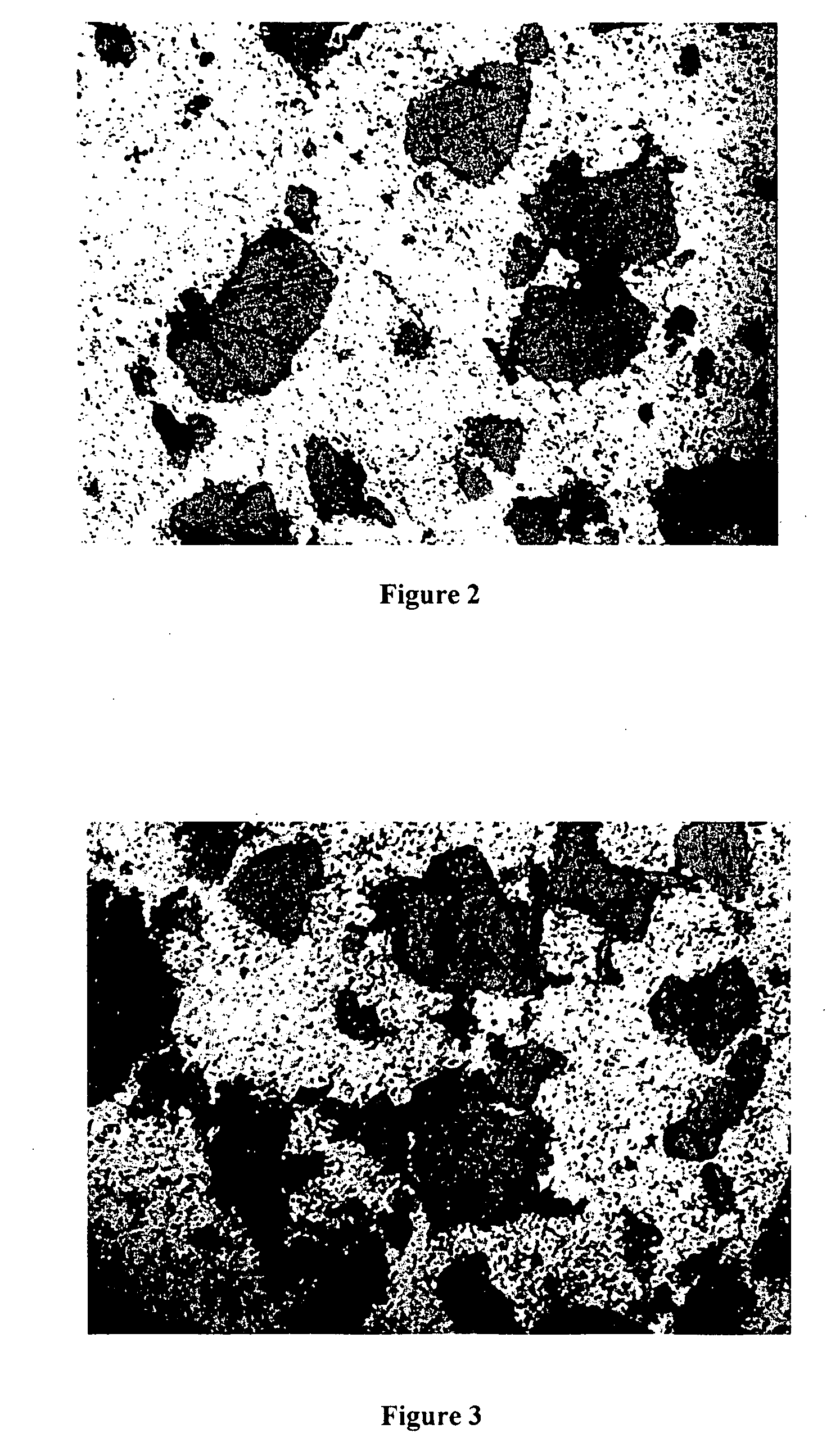Ceramic composite body of silicon carbide/boron nitride/carbon
- Summary
- Abstract
- Description
- Claims
- Application Information
AI Technical Summary
Benefits of technology
Problems solved by technology
Method used
Image
Examples
example 1
Control Experiment 1
[0028] A premix for making sintered silicon carbide was made according to the following composition:
IngredientWeight PercentSilicon carbide91.2Boron carbide0.8Phenolic resin5.0Oleic acid3.0
[0029] The silicon carbide used was high purity, sub-micron sinterable powder, obtained from Xinfang Abrasives Company, China. The average particle size of the powder was about 0.7 micrometer. The as-received silicon carbide contained about 0.8 weight percent of boron carbide sintering aids already added in the powder. The powder was mixed proportionally with phenolic resin, oleic acid and distilled water to form slurry containing 40 percent solids, and then milled for 4 hours in a rubber lined ball mill using silicon carbide balls. The slurry was then spray dried into moldable granules. The spray-dried silicon carbide powder was pressed to shape in a die, under a pressure of 12 ton per square inch, and then the green body was cured at 150° C. for 4 hours, heated in a furna...
example 2
Control Experiment 2
[0030] Hexagonal phase boron nitride powder, grade CTL30, was obtained from Saint Gobain Advanced Ceramics Corporation. The average size of the powder was 10.3 micrometers and the maximum size was 62.0 micrometers. The powder contained less than one percent oxygen. The spray-dried silicon carbide premix prepared in Example 1 and as-received boron nitride powder, in various ratios, was mixed thoroughly in a per square inch, and then the green body was cured at 150° C. for 4 hours, heated in a furnace to 600° C. at a heating rate of 60° C. per hour under nitrogen flow, to decompose the temporary binders and carbonize phenolic resin. The pre-fired body is then sintered in a vacuum sintering furnace, to temperatures up to 2100° C. over a period of 8 hours, under argon atmosphere. After sintering, the composite ceramic body density was calculated by measuring weight and volume. Samples were boiled in hot water for 30 minutes, and then weighted to measure the water a...
example 4
[0032] A composite body was prepared using identical process as in Example 3, except the weight percent of the resin-boron nitride granules in the raw batch was 20 weight percent. The resulting composite body had a density of 2.61 g / cc and water adsorption of 5 percent. To fill the open porosity in the body, the composite body was placed in a pressure tank, vacuumed to 1 torr and then filled with furfuryl alcohol resin, pressurized to 100 psi using compressed air, and kept under pressure for 24 hours. The impregnated body picked up 4.2 percent furfuryl alcohol resin, measured by the weight gained. The resulting body was cured in an air convection oven at 150° C. for 4 hours, heated in a furnace to 600° C. at a rate of 60° C. pre hour under nitrogen flow to carbonize the furfuryl alcohol resin. FIG. 3 is an optical photomicrograph taken at 150 magnifications, of a polished surface of the composite body, wherein the inter-connected porosity is filled with glassy carbon. The photomicro...
PUM
| Property | Measurement | Unit |
|---|---|---|
| Fraction | aaaaa | aaaaa |
| Percent by mass | aaaaa | aaaaa |
| Percent by mass | aaaaa | aaaaa |
Abstract
Description
Claims
Application Information
 Login to View More
Login to View More - R&D
- Intellectual Property
- Life Sciences
- Materials
- Tech Scout
- Unparalleled Data Quality
- Higher Quality Content
- 60% Fewer Hallucinations
Browse by: Latest US Patents, China's latest patents, Technical Efficacy Thesaurus, Application Domain, Technology Topic, Popular Technical Reports.
© 2025 PatSnap. All rights reserved.Legal|Privacy policy|Modern Slavery Act Transparency Statement|Sitemap|About US| Contact US: help@patsnap.com


